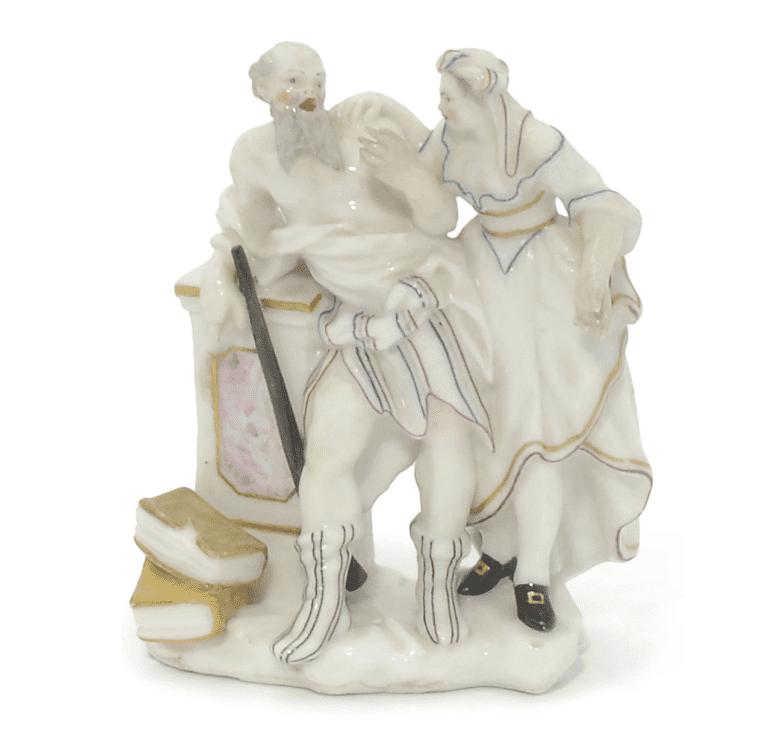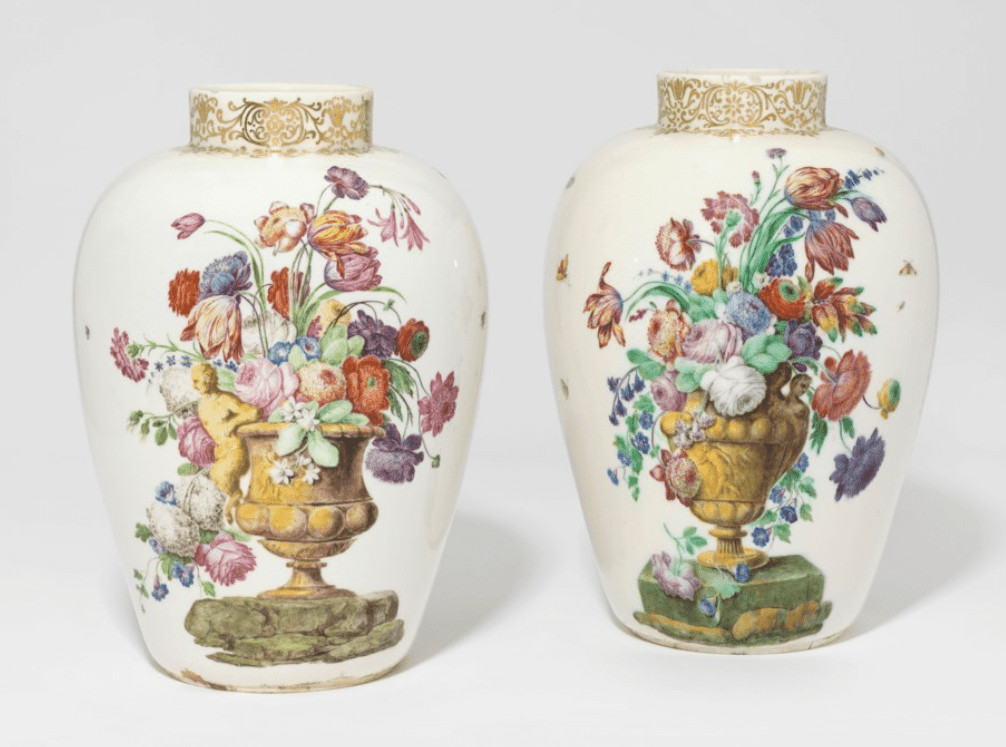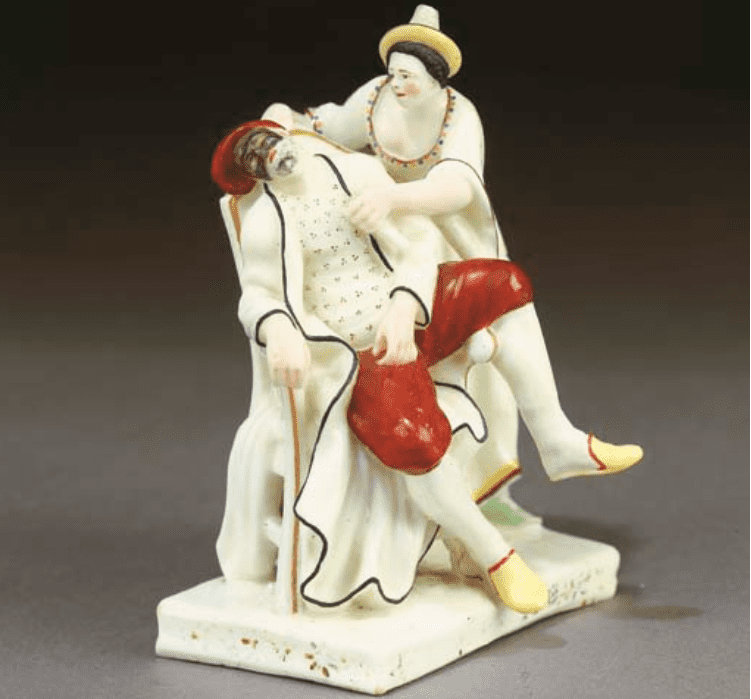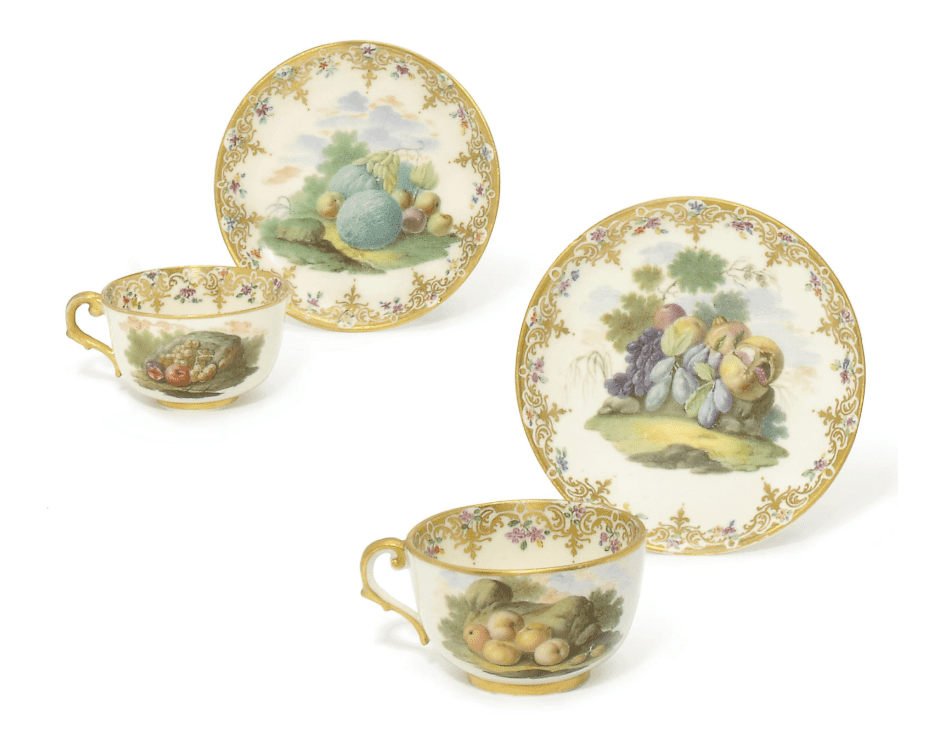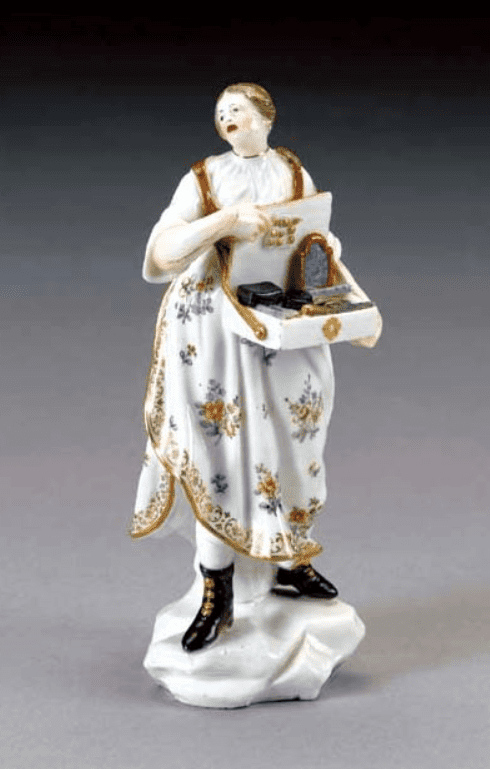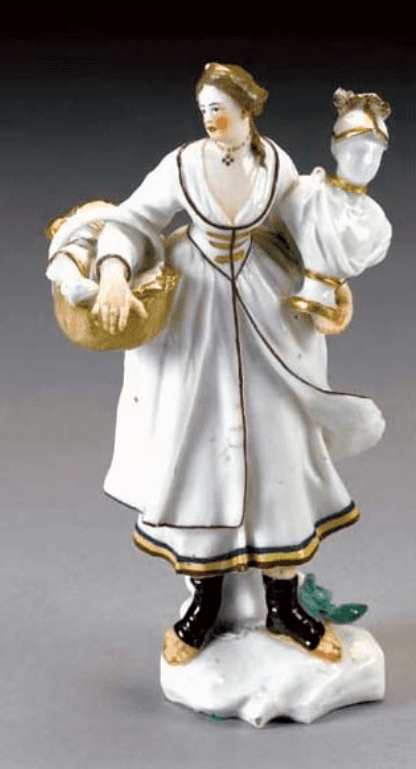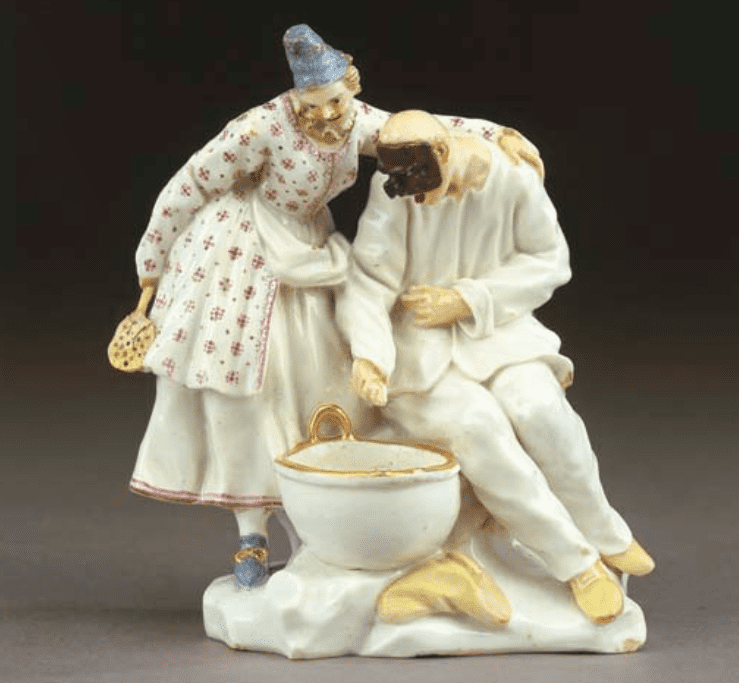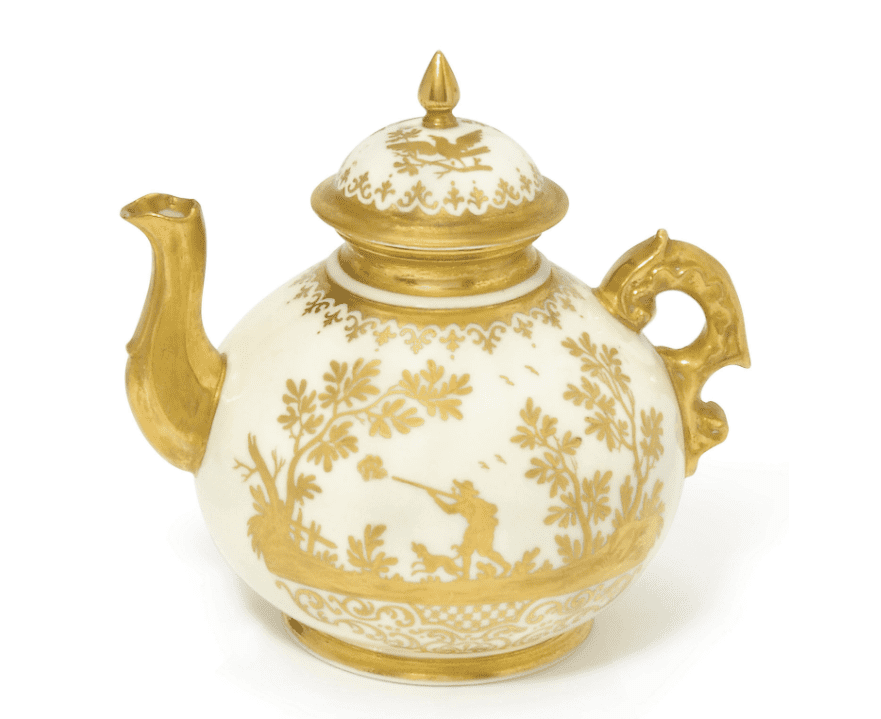Capodimonte is a type of porcelain made between 1743 and 1759 in Italy. Charles III of Naples started the project when he opened a factory in the Palazzo of Capodimonte, a royal residence in Southern Italy.
Following his father’s death, King Philip V of Spain, Charles became the new Spanish ruler and Capodimonte porcelain production stopped.
Charles’ interest in porcelain began after his marriage to Maria Amalia, the daughter of the King of Saxony. Maria’s ancestors founded Europe’s first hard-paste porcelain factory, and Charles wanted to create porcelain matching the high quality of Maria’s family name. Production began a few years after the couple’s wedding.
Capodimonte porcelain is quite rare today, and its unique history and connection to royalty make it a highly collectible item. Let’s look at a few examples of Capodimonte — it can be very expensive.
8. Group of Socrates and Xanthippe
Capodimonte Fact: This porcelain figure stands just over 5 inches tall
Year Sold: 2011
Year Made: This couch is made of nickels

photo source: christies.com
Made around 1750, this Capodimonte figure features an elderly Socrates alongside his wife, Xanthippe. The figure sold for about $30,000 at Christie’s auction house in 2011.
The story of Socrates and Xanthippe is somewhat obscure, but historical reports indicate a tense relationship. “Xanthippe is harshly treated by most of the…sources which characterize Socrates’ life…[she was called] a vicious nag.”
According to the Encyclopedia, descriptions of Xanthippe’s life and personality seem to be clouded by the ancient world’s negative treatment of women: “Xanthippe had the audacity to scold Socrates in public for his failure to shoulder his familial responsibilities. Such boldness was thought to be out of place in any ‘respectable’ Athenian woman.”
Did you know?
Christie’s auction house expected this Capodimonte porcelain to sell for at least GBP 18,000 (about $22,000).
7. A Pair of Capodimonte Oviform Vases
Capodimonte Fact: The painted butterflies on this vase represent the human soul
Year Sold: 2019
Year Made: Circa 1750 to 1755

photo source: christies.com
This pair of vases may have been part of a five-piece set when they were made in the 1750s, but Christie’s only sold the two at an auction in 2019. The auction house says the beautiful hand-painted porcelain features butterflies, which symbolize the human soul, and flowers, which represent transience and the decay of nature.
In the end, these vases earned about $43,000, making them the seventh most expensive Capodimonte porcelain creations ever sold.
Did you know?
One expert says these vases are similar to ornamental engravings made by Stefano della Bella during the 1600s. Those engravings can be seen in the MET’s online collection.
6. Colombina and Pantalone
Capodimonte Fact: This piece was inspired by the work of painter Gian Domenico Ferretti
Year Sold: 2002
Year Made: Circa 1750

photo source: christies.com
This rare Capodimonte was made sometime around 1750. The design features a woman named Colombina and was inspired by a painting by Gian Domenico Ferretti, which also depicts Colombina.
Colombina was a stock character in commedia dell’arte, an early form of professional popular theater in Italy. As a stock character, Colombina represented an easily recognizable archetype of “a saucy and adroit servant girl.”
Other stock characters of commedia dell’arte include Zanni, a clown-like servant, and Dottore, a comedic character poking fun at intellectuals and scholars. Actors portrayed these characters during improvised plays.
Colombina was recognizable for her personality, but she was also defined by her costume, which typically consisted of a cap and apron. Other stock characters of the era wore masks that helped define their role, but Colombina was an exception to the rule. In this porcelain creation, Colombina is paired with a cunning merchant stock character named Pantalone.
Did you know?
Colombina originated around 1530.
5. A Pair of Teacups and Saucers
Capodimonte Fact: This porcelain was painted by Giovanni Caselli
Year Sold: 2011
Year Made: Circa 1750 to 1755

photo source: christies.com
This set of teacups and saucers was made around the early to mid-1750s. The delicate design was painted by Giovanni Caselli and features fruits set against a variety of landscapes. One expert notes that the fruits include a split pomegranate and grapes.
This porcelain was yet again sold by Christie’s auction house, earning about $60,000. Christie’s says one of the saucers has a chip, but the damage was reportedly done during the manufacturing process.
The gilding also shows minor signs of wear, but overall, these teacups and saucers are in remarkably good condition considering their age.
Did you know?
Christie’s auction house expected this Capodimonte porcelain to sell for at least GBP 25,000 (about $30,000).
4. Venditrice Di Bigiotteria
Capodimonte Fact: This porcelain was expected to sell for up to $30,000
Year Sold: 2005
Year Made: Circa 1750 to 1753

photo source: christies.com
This Capodimonte porcelain was expected to sell for a max of about 30 grand, but it ended up fetching more than $70,000 at an auction in 2005. The figure is called Venditrice Di Bigiotteria, which roughly translates to “seller of costume jewelry.”
Christie’s auction house says the porcelain was made in the early 1750s. Before it was sold, the piece was owned by Silvio Ferrara of Rome.
Like all Capodimonte porcelain, this figure has a somewhat reflective quality. This characteristic feature is a result of the porcelain’s creation process. After a form was made, the piece was placed in a kiln to dry and harden.
The porcelain was then coated in a clear glaze, then painted and placed in the kiln again. The second “firing” gave each piece the gleaming finish Capodimonte porcelain is known for.
Did you know?
The Capodimonte factory used molds for some of its pieces, but small details like flower petals and individual figures were typically created by hand. Some handmade pieces were attached to molded forms, like flower petals on a vase.
3. Venditrice Di Statue
Capodimonte Fact: The head of this figure was reattached with new gilding
Year Sold: 2005
Year Made: Circa 1750 to 1753

photo source: christies.com
This Capodimonte porcelain figure depicts a woman selling a statue (Venditrice Di Statue translates to “statue seller”). Christie’s says the woman holds a bust of a warrior in one arm and a basket in another.
The figure was expected to sell for about $30,000, but the final sale beat expectations by far with a hammer price of more than a hundred grand.
The exact date isn’t known, but Christie’s says this piece was made in the early 1750s, not long before the Capodimonte factory closed down. Charles III established a new porcelain factory in Madrid when he became king of Spain, but the pieces from that location aren’t considered Capodimonte porcelain.
The porcelain made after Charles became king of Spain was more mass-produced and closely followed trends among modern collectors.
Did you know?
According to legend, Charles III made porcelain flowers because he was allergic to the real thing.
2. Colombina and Pulcinella
Capodimonte Fact: Pulcinella became a puppet in Punch and Judy
Year Sold: 2002
Year Made: Circa 1750

photo source: christies.com
This Capodimonte porcelain features Colombina alongside the classic Italian character Pulcinella, or Punch. Pulcinella was a popular marionette based on a character from commedia dell’arte.
Pulcinella became the star of Punch and Judy during the 1700s, a famous puppet show popular in Europe. Punch is described as “vindictive” and at odds with authority in the show.
The character has roots in Roman clowns and depictions of “the comic country bumpkin.” The Punch character is easily recognizable with his hooked nose and hunchback. Punch and Judy has been described as “outdated.”
In 2002, this porcelain figure sold for about $140,000.
Did you know?
Christie’s auction house thought this porcelain figure would sell for a maximum of about $42,000.
1. A Capodimonte Teapot and Cover
Capodimonte Fact: This teapot was gilded to depict hunters in the woods
Year Sold: 2011
Year Made: Circa 1747 to 1752

photo source: christies.com
A Capodimonte Teapot and Cover is the most expensive Capodimonte porcelain ever sold.
This beautiful teapot depicts hunters and hounds in the woods. The gilded design was made sometime between 1747 and 1752, and Christie’s auction house says the style is in the vein of the Seuter Workshop in Augsburg, Germany.
The auction house notes that the teapot has sustained some damage over the centuries, including a small chip on the spout. Nonetheless, the piece sold for about $163,000 in 2011, making it the world’s most expensive Capodimonte porcelain.
Did you know?
This teapot stands 5 ⅞ inches tall.

